“Ptosis”: How to Notice and Fix It
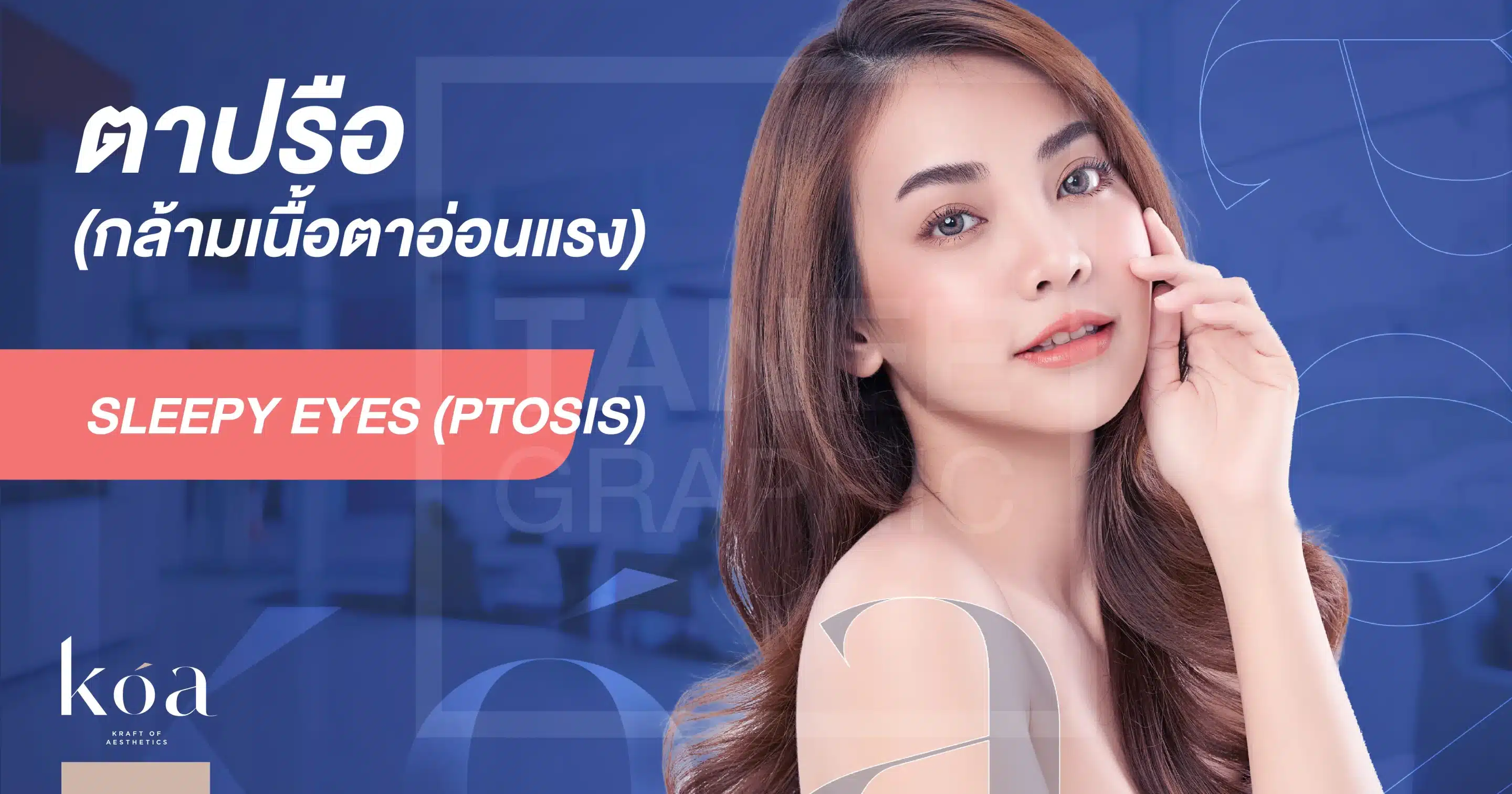
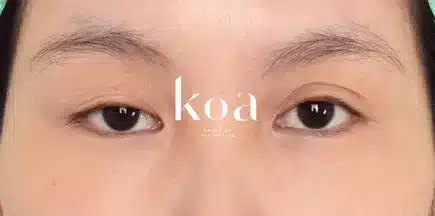
Do you ever feel like your eyes look smaller or tired in the mirror, even when you’re awake and refreshed? If you’ve had these experiences, it’s possible that you might be dealing with a condition known as “Ptosis”.
Today, KOA Clinic will introduce you to the causes behind these symptoms, including eyes that seem smaller, sleepy eyes, and a perpetually tired appearance. Additionally, we’ll provide guidance on “Ptosis Correction”. If you want to learn more, you can read the article and take a closer look in the mirror to discover our solutions and recommendations.
What is Ptosis?
Ptosis is a condition where one or both eyelids cannot fully open. This leads to the appearance of smaller or partially closed eyes. To determine if you have ptosis, stand in front of a mirror and compare your eyes to the reference image provided below.
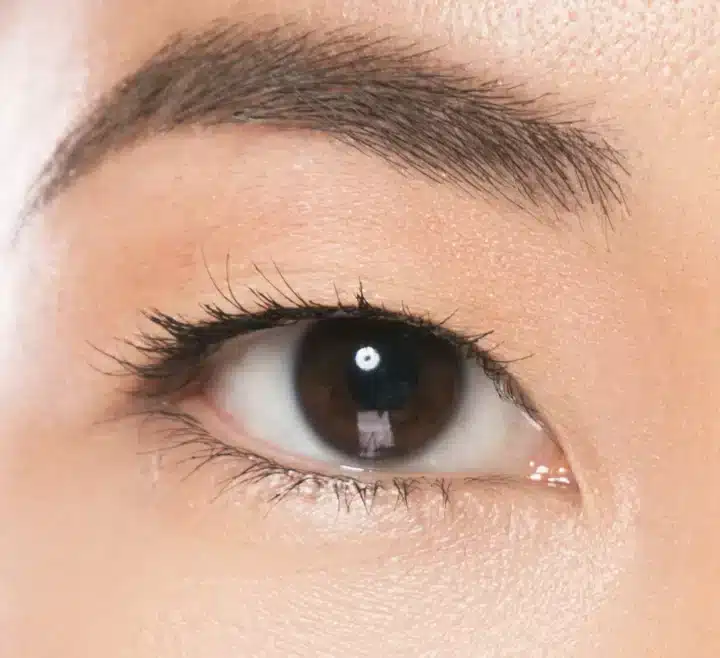
Our front colored-eye is naturally “round,” and for most people, the upper eyelid (where the eyelashes are) slightly covers the upper portion of the eye, usually no more than 2 mm. This allows us to see most of the round shape of the front colored-eye. However, if the upper eyelid droops and covers more than 2 mm. of the eye, it can cause the appearance of “smaller” eyes. We refer to this condition as “Ptosis.”
Additionally, individuals with ptosis might also develop hollow eyes or sunken eyes.
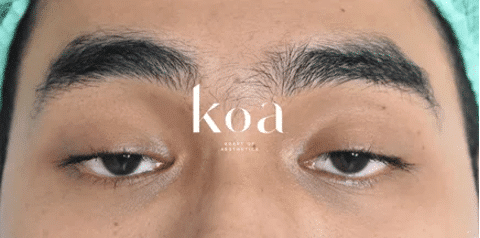
If you experience these symptoms and want to undergo Ptosis Correction to help your eyes open up, you can send photos to the LINE account “@koaclinic ” for a “free” consultation.
What causes Ptosis?
Ptosis occurs when the muscles responsible for raising the eyelids (named Levator palpebrae superioris or levator) are not functioning properly. This leads to difficulty in opening the eyes fully, causing them to appear smaller or droopy. The common causes of Ptosis include:
1. Present from Birth (Congenital ptosis)
Occurs due to poor development of the levator muscles, resulting in weakened muscles. This particular issue is quite evident as it can be observed from a very young age.
2. Age-Related Weakening (Aponeurotic ptosis)
This is the most common cause, often resulting from the natural aging process. With increasing age, the levator muscles weaken and lose strength.
3. Diseases or Other Injuries
This is a less common cause, such as diseases of the muscles or certain nerve systems, eye injuries, the presence of large eyelid mass, or frequent and prolonged eye rubbing. These factors may negatively impact the function of the levator muscles.
4. Side Effects from Upper Eyelid Surgery
In individuals who undergo double eyelid surgery, particularly for excessively thick eyelids or other upper eyelid procedures, the levator muscles’ function may be compromised, leading to weakness
Is Ptosis Dangerous? What are its effects?
Ptosis is not severely dangerous to the body but can have negative effects on vision, aesthetics, and discomfort around the eyes. More details are provided below.
1. Negative Effects on Vision:
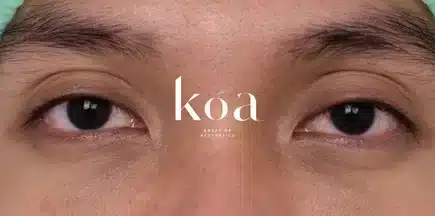
We perceive images through the pupil of the eye. Therefore, individuals with severe Ptosis that results in minimal pupil opening may experience reduced field of vision.
2. Negative Effects on Aesthetics:
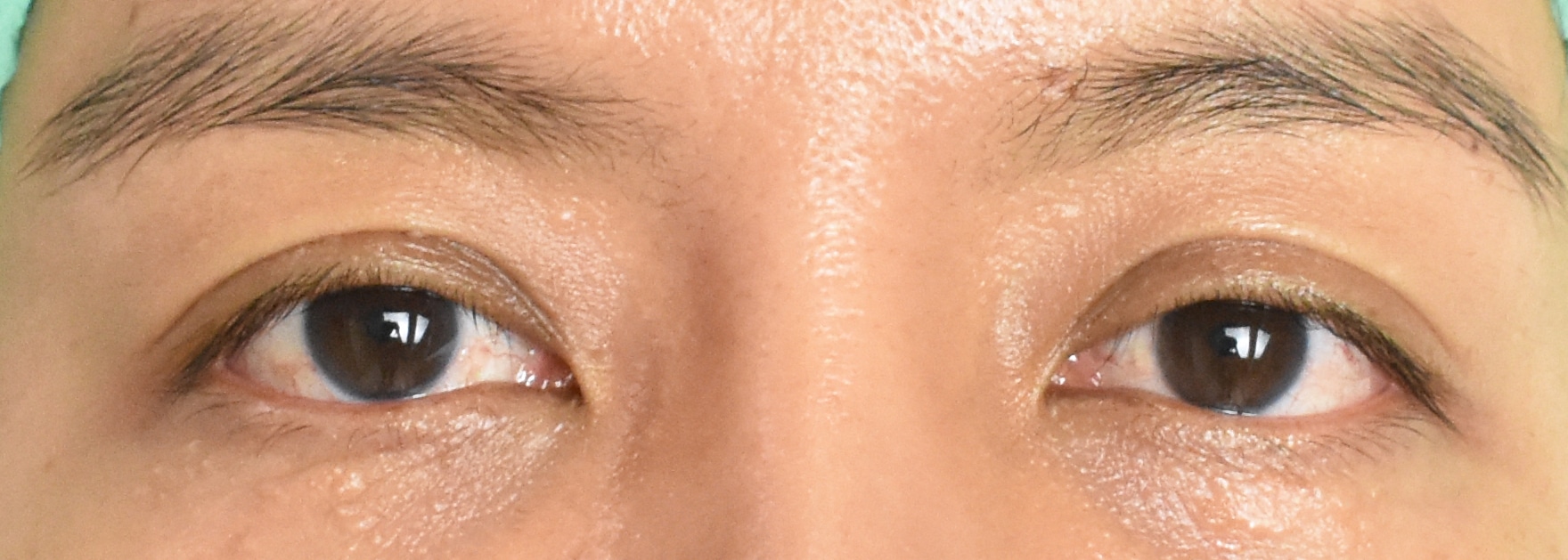
When the upper eyelid droops and the double eyelid is not well-defined, it can make the eyes appear less vibrant and lively, impacting personal appearance. This can lead to teasing by peers for appearing tired in photographs. It might also affect certain professions that require a good appearance, such as emcees, flight attendants, or actors.
3. Impact on Sensation Around the Eyes:
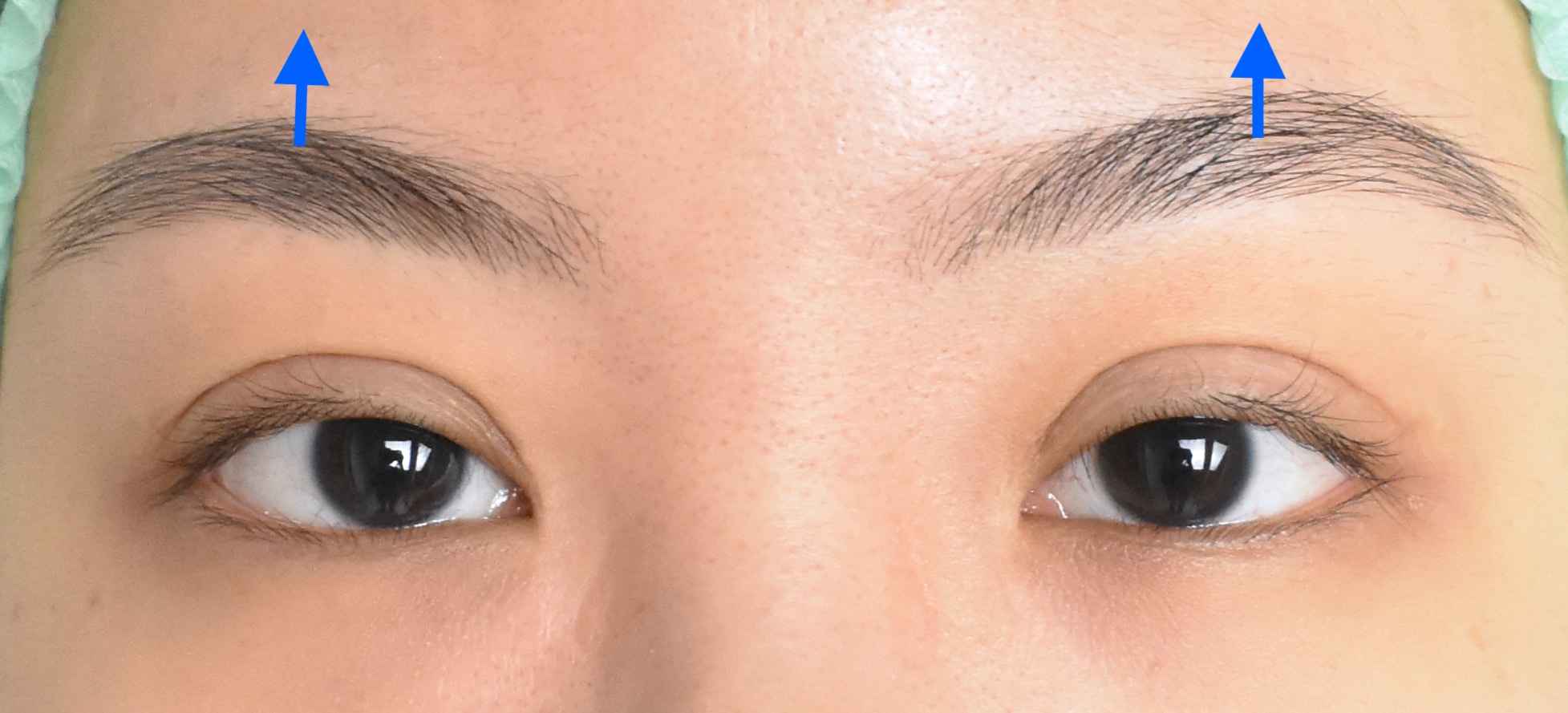
When the eyelid droops, the body’s automatic response is to activate the eyebrow and forehead muscles to lift the eyelid, resulting in a raised brow. Therefore, individuals with ptosis might frequently have raised eyebrows. This prolonged eyebrow elevation could lead to eyestrain or chronic headaches. This phenomenon might also occur in individuals who have had double eyelid surgery with excessively thick upper eyelids, causing the levator muscle to work harder.
Ptosis Correction
If Ptosis occurs, it’s important to consult a physician to determine the underlying cause. Individuals with congenital, age-related, or post-surgical Ptosis can often benefit from corrective surgery, which generally provides satisfactory outcomes. However, for those with diseases, injuries, or complex cases, treatment might involve more detailed assessments to address the underlying issues.
Ptosis Correction Surgery
KOA Clinic offers 3 main surgical techniques for correcting Ptosis
1. External ptosis correction
This method involves making an incision on the eyelid skin, similar to the technique used in double eyelid surgery. The doctor will open the incision along the eyelid crease to access the eye-lifting muscle and repair them to enhance the opening strength of the eyelid.
External ptosis correction can address various issues related to weak eyelid-lifting muscle, and it can be combined with double eyelid surgery to enhance the beauty of the eyelids. Additionally, it allows for the removal of excess or sagging eyelid skin.
Suitable For:
- Anyone 18 years and older
- Those with mild to severe cases of Ptosis
- People with Ptosis who also desire improved double eyelid shape or need correction of sagging or drooping eyelid
Not Suitable for:
- Those wanting to avoid surgical incisions on the skin
2. Internal ptosis correction
In this method, the doctor flips the eyelid skin and performs the surgery from the inside. One major advantage of this approach is that the recovery period is relatively fast, and there are no visible surgical scars. This technique is particularly effective for correcting mild to moderate cases of Ptosis.
Suitable for:
- Individuals who already have double eyelids but have mild to moderate ptosis.
- People who want to avoid visible surgical scars.
- Those who wish to have a natural-looking enlargement of the eyes.
Not Suitable For:
- Individuals with moderate to severe ptosis.
- People with additional eye-related issues such as loose eyelid skin or sunken eyes.
- Those who want to undergo a double eyelid procedure in combination with Ptosis correction.
3. Advanced technique for severe cases or post-multiple surgeries
This method is reserved for severe cases or individuals with repeated surgeries that have led to tissue damage. Adjacent muscles or tissues, such as those in the forehead or inside the deep eyelid tissue, can be used to aid in eyelid opening.
Suitable for:
- Individuals with severe Ptosis or those who have undergone multiple previous eyelid surgeries that have resulted in significant tissue damage.
Precautions in Ptosis Correction Surgery
Dr. Korn would like to bring your attention to Myasthenia Gravis (MG) as it is a condition he considers a somewhat overlooked yet significant cause of Ptosis. This is particularly noteworthy because, throughout his medical career, Dr. Korn has encountered approximately 5 to 6 patients who initially sought advice for Ptosis but were ultimately diagnosed with MG
However, treatment methods might be more complex for those with conditions arising from injury, trauma, or other less common causes. Preliminary observation can be done by examining symptoms and considering other related medical history. For instance, if there are inconsistent levels of eyelid drooping on different days or if the drooping worsens during activities like chewing, it might be indicative of an underlying issue. If unsure, consult with an ophthalmologist for a detailed analysis of the underlying causes.
MG is a condition related to abnormal immune responses. It often occurs in women of working age, around 30-40 years old. Commonly, it presents with unilateral ptosis and varying degrees of symptoms throughout the day. Symptoms tend to be better in the morning, with more pronounced drooping in the afternoon or evening.
One must beware since MG can lead to weakness in other muscles of the body and pose risks to overall health. Treatment approaches typically involve medications or other non-surgical methods. If diagnosed with MG, opting for Ptosis correction surgery might be the wrong answer and could potentially be risky in the future.
For individuals experiencing these symptoms or suspecting MG, scheduling a preliminary examination with Dr. Korn is advisable.
To Sum Up:
- Ptosis can result in incomplete eyelid opening, partial visibility of the eyes, and droopy and sleepy-looking eyes, which negatively affect one’s appearance. In severe cases, it can impact vision and the sensation of eyelid heaviness.
- Ptosis can arise from various causes, such as congenital factors, age-related, underlying diseases such as MG, or complications from previous upper eyelid surgeries.
- KOA Clinic offers three surgical techniques for Ptosis Correction: External incision, Internal incision and Advanced technique.
- Those with Ptosis can directly consult at KOA Clinic. Dr. Korn, our experienced ophthalmologist, is ready to provide care for everyone.
If you’re interested in Ptosis correction, send photos for evaluation or schedule an appointment via LINE @koaclinic. Consultation is “free” of charge!
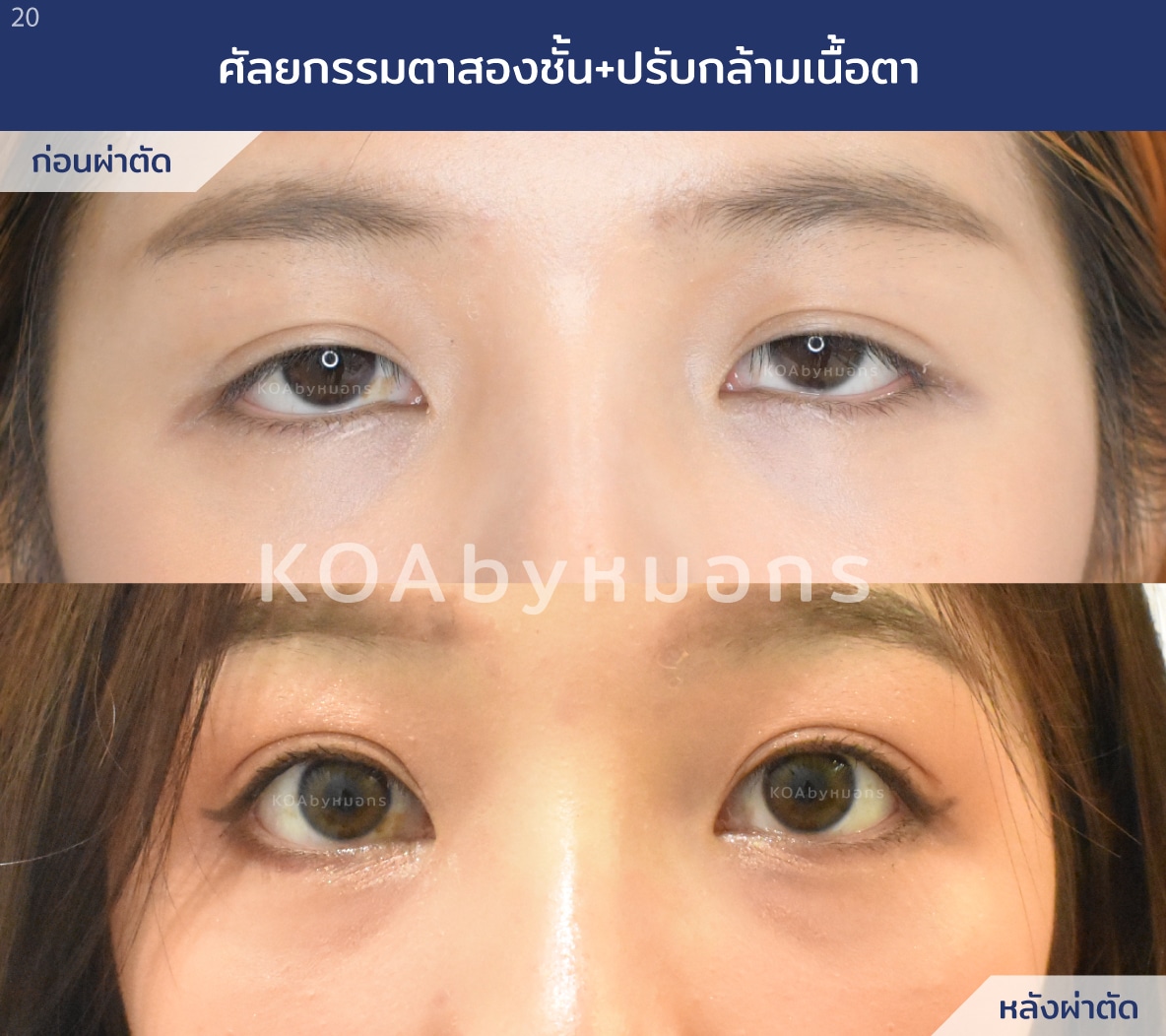
Frequently Asked Questions (FAQs) About Ptosis
-
It depends on the cause. If the ptosis is due to muscle weakness or congenital factors, surgical intervention is usually necessary. However, if it’s caused by other factors, such as Myasthenia Gravis (MG) or abnormalities in the third cranial nerve, surgery might not be necessary.
-
It might provide slight improvement, but if the double eyelid is made too thick, it might lead to even more drooping than before.
-
It can be determined from your medical history and other symptoms. Factors like eyelid drooping since birth, any pre-existing conditions, or consistent drooping throughout the day can be indicative. If you’re unsure or worried, consulting with an ophthalmologist is recommended.
-
The position of the incision might not differ significantly, but the techniques and surgical details are relatively different.
-
In general, if the eyes are extremely sunken, combining fat injection with ptosis correction surgery might be considered.
-
Ptosis Correction through an external approach often covers various issues. However, the most suitable technique might vary for each individual and can be determined by the doctor.
-
Generally, Ptosis Correction surgery can help elevate the eyelid and widen the visible area of the eye. However, if uncertain or worried about the surgical outcomes, you can consult with the doctor beforehand.
-
The level of pain varies among individuals. Typically, KOA Clinic provides various medications to minimize pain during the recovery period.
-
Yes, double eyelid surgery can be done solely, however, it might not correct the Ptosis condition, and double eyelid creases are usually thicker than expected.
-
Yes, the doctors at KOA Clinic are very friendly and attentive to every case. If you have issues related to Ptosis, drooping eyelids, or other concerns, don’t hesitate to consult with KOA Clinic either in person or through our LINE account “@koaclinic” for a free evaluation.




